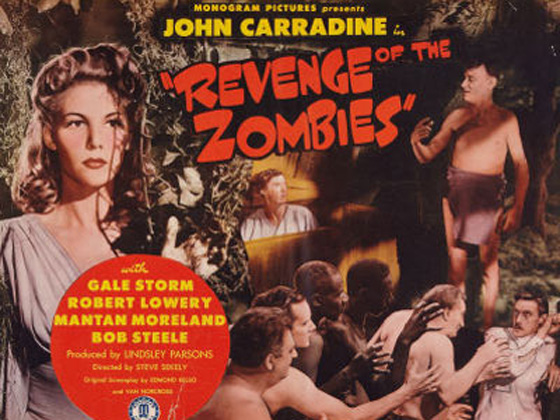 Poor Dr. Von Altermann. He has at long last perfected a method for resurrecting the dead, setting him on the path to mustering an army of zombies for Hitler. Dreams of world domination by the Nazi walking dead seem irresistibly close to fulfillment. But surely he hadn’t counted on the zombies being slow, lumbering, ineffectual, laboriously comic, and not in the least bit lethal. Worse, after reviving the corpse of his wife, she refuses to obey any of his commands. It’s like she never changed. And Hitler checks up on him only by sending a Nazi flunky who can’t even handle a German accent. So you see, Von Altermann ought to elicit our pity, and yet, as played by John Carradine, he often just stands there proudly while his snooping guests sneak about the house, and flaunts his zombie servants as though confident his evil plot could never be discovered. So the eventual collapse of all his dreams is less inevitable than about sixty minutes overdue.
Poor Dr. Von Altermann. He has at long last perfected a method for resurrecting the dead, setting him on the path to mustering an army of zombies for Hitler. Dreams of world domination by the Nazi walking dead seem irresistibly close to fulfillment. But surely he hadn’t counted on the zombies being slow, lumbering, ineffectual, laboriously comic, and not in the least bit lethal. Worse, after reviving the corpse of his wife, she refuses to obey any of his commands. It’s like she never changed. And Hitler checks up on him only by sending a Nazi flunky who can’t even handle a German accent. So you see, Von Altermann ought to elicit our pity, and yet, as played by John Carradine, he often just stands there proudly while his snooping guests sneak about the house, and flaunts his zombie servants as though confident his evil plot could never be discovered. So the eventual collapse of all his dreams is less inevitable than about sixty minutes overdue.
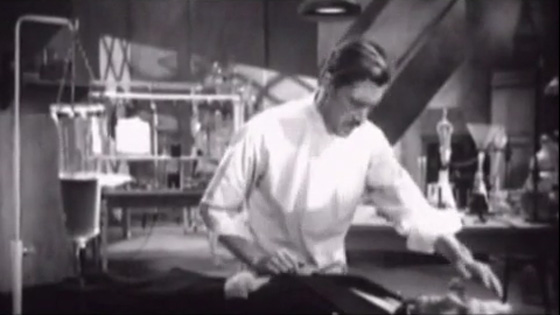 Revenge of the Zombies was released in 1943, the same year as I Walked with a Zombie, the Jacques Tourneur/Val Lewton film which rose above its pulpy title to become an authentic classic. But although both zombie films take place in claustrophobic sets of mist-enshrouded swamps and plantations, they don’t occupy the same universe. Lewton strove to make his pictures literary, atmospheric, and suffused with dread. Revenge of the Zombies director Steve Sekely only hopes to fill out sixty minutes with enough generic incident that it can qualify as a motion picture. One gets the feeling that he thought it would be enough to just cast the skeletal, sonorous Carradine, as well as Mantan Moreland, the prolific African-American actor whose gift for comedy was forever hitched to demeaning roles. As Jeff, the driver, his job here is to look at zombies, bulge out his eyes, drop a one-liner, and run off the screen. His part is made slightly bearable by Sybil Lewis as a sexy and smart African-American maid, bearing a passing resemblance to a live-action Betty Boop. I wanted more of Lewis and less of Moreland, but it should be obvious to any modern viewer that the blame for their wasted talent lies with neither of them.
Revenge of the Zombies was released in 1943, the same year as I Walked with a Zombie, the Jacques Tourneur/Val Lewton film which rose above its pulpy title to become an authentic classic. But although both zombie films take place in claustrophobic sets of mist-enshrouded swamps and plantations, they don’t occupy the same universe. Lewton strove to make his pictures literary, atmospheric, and suffused with dread. Revenge of the Zombies director Steve Sekely only hopes to fill out sixty minutes with enough generic incident that it can qualify as a motion picture. One gets the feeling that he thought it would be enough to just cast the skeletal, sonorous Carradine, as well as Mantan Moreland, the prolific African-American actor whose gift for comedy was forever hitched to demeaning roles. As Jeff, the driver, his job here is to look at zombies, bulge out his eyes, drop a one-liner, and run off the screen. His part is made slightly bearable by Sybil Lewis as a sexy and smart African-American maid, bearing a passing resemblance to a live-action Betty Boop. I wanted more of Lewis and less of Moreland, but it should be obvious to any modern viewer that the blame for their wasted talent lies with neither of them.
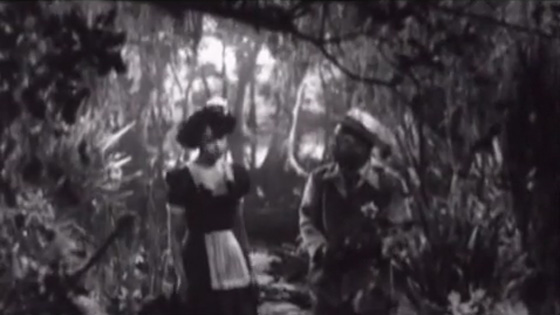 Our heroes, on the other hand, are the blandest slices of white bread the screenwriters could serve up. Scott Warrington (Mauritz Hugo) and Larry Adams (Robert Lowery) visit the estate of Dr. Von Altermann because his wife (Veda Ann Borg) – Warrington’s sister – has just passed away; but the two are convinced that the shady doctor had something to do with her death, so they decide to swap identities. What this should accomplish is deliriously unclear. Von Altermann has met neither one of them before, which allows them to pursue this ruse, but it gains them exactly nothing. The central purpose seems to be to help the plot keep up appearances. As though we have cornered the plot, and the plot defensively declared, “Look, I’m doing something, okay? Warrington is Adams and Adams is now Warrington. Stuff is happening – see?” Late in the film, over dinner, Warrington stands up and declares: “I’m Scott Warrington!” John Carradine seems unimpressed, Warrington sits down, and the movie continues.
Our heroes, on the other hand, are the blandest slices of white bread the screenwriters could serve up. Scott Warrington (Mauritz Hugo) and Larry Adams (Robert Lowery) visit the estate of Dr. Von Altermann because his wife (Veda Ann Borg) – Warrington’s sister – has just passed away; but the two are convinced that the shady doctor had something to do with her death, so they decide to swap identities. What this should accomplish is deliriously unclear. Von Altermann has met neither one of them before, which allows them to pursue this ruse, but it gains them exactly nothing. The central purpose seems to be to help the plot keep up appearances. As though we have cornered the plot, and the plot defensively declared, “Look, I’m doing something, okay? Warrington is Adams and Adams is now Warrington. Stuff is happening – see?” Late in the film, over dinner, Warrington stands up and declares: “I’m Scott Warrington!” John Carradine seems unimpressed, Warrington sits down, and the movie continues.
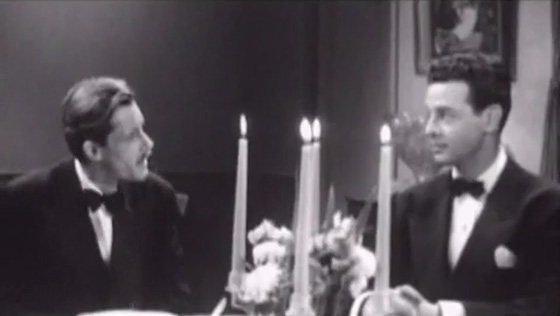 In a desperate gamble for even more generic incident, Revenge of the Zombies serves up dialogue scene after dialogue scene, everyone breathlessly panting away as though the words spilling from their mouths advance some compelling agenda, which they do not. It has the feel of a filmed radio drama. On rare occasions we leave the confines of the mansion and step out into the swamps, where the zombies are summoned by calling, “Aaaaaah-ooooooooh.” Sort of like a Tarzan yell, if Tarzan were trying to be a bit quieter and less imposing. Then the zombies gather, shuffling about, eyes cast down. Near as I can figure, Dr. Von Altermann’s zombie army consists of four heavyset black men and two very underfed white guys. When the doctor announces, midway through the film, that his masters will be pleased, you have to wonder if he’s really thought this whole thing out. But he does helpfully explain the zombies’ invulnerability, impervious to poison gas and bullets. To demonstrate the latter, he quickly shoots his zombie wife. You see? They can stand up to anything, “so long as the brain cells which receive and execute commands still remain intact.” Even in 1943, zombie experts were suggesting you aim for the head.
In a desperate gamble for even more generic incident, Revenge of the Zombies serves up dialogue scene after dialogue scene, everyone breathlessly panting away as though the words spilling from their mouths advance some compelling agenda, which they do not. It has the feel of a filmed radio drama. On rare occasions we leave the confines of the mansion and step out into the swamps, where the zombies are summoned by calling, “Aaaaaah-ooooooooh.” Sort of like a Tarzan yell, if Tarzan were trying to be a bit quieter and less imposing. Then the zombies gather, shuffling about, eyes cast down. Near as I can figure, Dr. Von Altermann’s zombie army consists of four heavyset black men and two very underfed white guys. When the doctor announces, midway through the film, that his masters will be pleased, you have to wonder if he’s really thought this whole thing out. But he does helpfully explain the zombies’ invulnerability, impervious to poison gas and bullets. To demonstrate the latter, he quickly shoots his zombie wife. You see? They can stand up to anything, “so long as the brain cells which receive and execute commands still remain intact.” Even in 1943, zombie experts were suggesting you aim for the head.
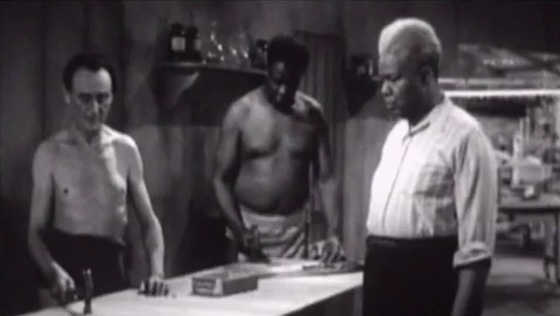 For a while, only Mantan Moreland notices that there are zombies crawling everywhere. He notices because one of the zombies tells him: “I drove beautiful car for Master…when I was alive.” This is spoken by the one nicknamed “Lazarus,” and I would suggest that if you want to keep your zombies secret from the outside world, you (a) don’t have them greet guests as they arrive at your house, and (b) don’t give them names like “Lazarus.” Moreland reacts to the zombies with his characteristic aplomb: “My head keep tellin’ my feet that ain’t no zombie, but my feet ain’t convinced,” he says, before running away yet again. When Warrington and Adams (or is it…Adams and Warrington?) finally confront Carradine over the nature of his plot, he tells them he’s creating an invincible army for Hitler. “Sounds impossible,” one of our interchangeable heroes retorts. “An army of robots, or automatons?” I love this line; it’s spoken as though Bela Lugosi lives down the street, constantly making headlines for his race-of-atomic-supermen schemes – so it’s gotta be robots or automatons.
For a while, only Mantan Moreland notices that there are zombies crawling everywhere. He notices because one of the zombies tells him: “I drove beautiful car for Master…when I was alive.” This is spoken by the one nicknamed “Lazarus,” and I would suggest that if you want to keep your zombies secret from the outside world, you (a) don’t have them greet guests as they arrive at your house, and (b) don’t give them names like “Lazarus.” Moreland reacts to the zombies with his characteristic aplomb: “My head keep tellin’ my feet that ain’t no zombie, but my feet ain’t convinced,” he says, before running away yet again. When Warrington and Adams (or is it…Adams and Warrington?) finally confront Carradine over the nature of his plot, he tells them he’s creating an invincible army for Hitler. “Sounds impossible,” one of our interchangeable heroes retorts. “An army of robots, or automatons?” I love this line; it’s spoken as though Bela Lugosi lives down the street, constantly making headlines for his race-of-atomic-supermen schemes – so it’s gotta be robots or automatons.
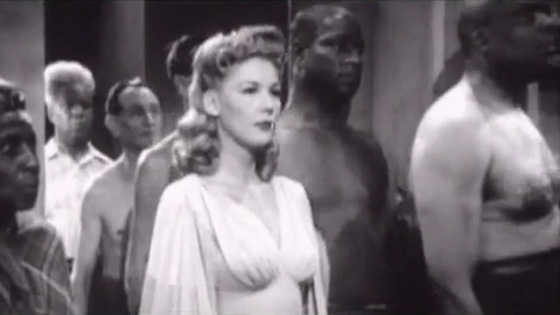 Over dinner, Carradine slips a mickey into a glass of wine which Adams drinks. A quick time transition is presented by a camera zoom on the table’s candle centerpiece as harp music plays. Larry, now succumbing to the mickey’s effect, puts his head on the table and says: “I feel druggy.” Triumphantly, Carradine drags the man off and ties him up in the closet, where (surprise!) a skeleton is hanging. He has to physically remove the skeleton in order to make room for Adams. A minute later, Adams frees himself from the ropes; they fall away pretty easily, so we can assume that Carradine is terrible with knots. (We learn that Adams was wise to Carradine’s plan and prepared to be drugged by taking the all-purpose antidote: coffee. Which, in retrospect, means that his “I feel druggy” line was just an acting flourish. Well played, sir.) When a sheriff is finally summoned to the Von Altermann estate, we see that he’s actually the Nazi flunky in disguise, and achieving a much better American accent than he’d managed with a German one. And that makes sense, because in a further twist, it’s revealed that he really is an American, an agent of the U.S. government who has been spying on Carradine. As they confront Carradine in his lab, the doctor commands his zombie army to attack. But his wife doesn’t listen and turns the other zombies against him. When last Dr. Von Altermann is seen, he’s deep in the swamp, and his wife is forcibly pushing him down into quicksand while he screams. Mantan Moreland departs with the ever-saucy Sybil Lewis, though she still puts him in his place with an emasculating one-liner. (A feminist paper could be written on Revenge of the Zombies, except that it would involve writing a paper on Revenge of the Zombies.) After the camera explores the set for a while, it finally discovers “The End” written on a closing door, followed by the familiar propaganda urging audiences to buy war bonds. Yes, in the war against the Axis powers, Poverty Row pictures were doing their part.
Over dinner, Carradine slips a mickey into a glass of wine which Adams drinks. A quick time transition is presented by a camera zoom on the table’s candle centerpiece as harp music plays. Larry, now succumbing to the mickey’s effect, puts his head on the table and says: “I feel druggy.” Triumphantly, Carradine drags the man off and ties him up in the closet, where (surprise!) a skeleton is hanging. He has to physically remove the skeleton in order to make room for Adams. A minute later, Adams frees himself from the ropes; they fall away pretty easily, so we can assume that Carradine is terrible with knots. (We learn that Adams was wise to Carradine’s plan and prepared to be drugged by taking the all-purpose antidote: coffee. Which, in retrospect, means that his “I feel druggy” line was just an acting flourish. Well played, sir.) When a sheriff is finally summoned to the Von Altermann estate, we see that he’s actually the Nazi flunky in disguise, and achieving a much better American accent than he’d managed with a German one. And that makes sense, because in a further twist, it’s revealed that he really is an American, an agent of the U.S. government who has been spying on Carradine. As they confront Carradine in his lab, the doctor commands his zombie army to attack. But his wife doesn’t listen and turns the other zombies against him. When last Dr. Von Altermann is seen, he’s deep in the swamp, and his wife is forcibly pushing him down into quicksand while he screams. Mantan Moreland departs with the ever-saucy Sybil Lewis, though she still puts him in his place with an emasculating one-liner. (A feminist paper could be written on Revenge of the Zombies, except that it would involve writing a paper on Revenge of the Zombies.) After the camera explores the set for a while, it finally discovers “The End” written on a closing door, followed by the familiar propaganda urging audiences to buy war bonds. Yes, in the war against the Axis powers, Poverty Row pictures were doing their part.









